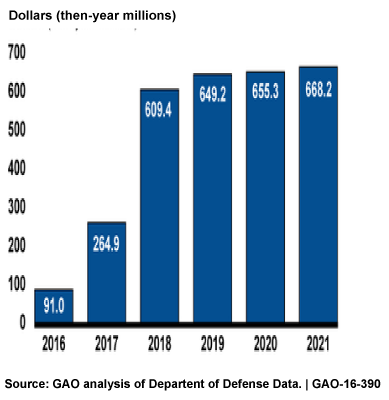
Last week, Arizona Senator John McCain was excited to announce that Davis-Monthan was in the running for F-35 basing. Not included in his announcement were the findings of a GAO report released to the public on April 14, in which the F-35 program was found to continue “to face significant affordability challenges.”
 The GAO did find that the estimated F-35 Joint Strike Fighter (F-35) program acquisition costs have decreased since 2014. However, the GAO believes that it “will be difficult for Congress” to hold the DOD “accountable for achieving its cost, schedule, and performance requirements.”
The GAO did find that the estimated F-35 Joint Strike Fighter (F-35) program acquisition costs have decreased since 2014. However, the GAO believes that it “will be difficult for Congress” to hold the DOD “accountable for achieving its cost, schedule, and performance requirements.”
“The Department of Defense (DOD) plans to begin increasing production and expects to spend more than $14 billion annually for nearly a decade on procurement of F-35 aircraft. Currently, the program has around 20 percent of development testing remaining, including complex mission systems software testing, which will be challenging,” reads the report in part.
While the Air Force continues to neglect the A-10, the DOD plans to manage F-35 modernization as part of the existing program baseline and is “exploring the use of a single contract to procure multiple lots” of future F-35.
“DOD has begun planning and funding significant new development work to add to the F-35’s capabilities. Known as Block 4, the funding needed for this effort is projected to be nearly $3 billion over the next 6 years, which would qualify it as a major defense acquisition program in its own right,” the report notes.
“DOD does not currently plan to manage Block 4 as a separate program with its own acquisition program baseline but rather as part of the existing baseline,” continues the report. “As a result, Block 4 will not be subject to key statutory and regulatory oversight requirements, such as providing Congress with regular, formal reports on program cost and schedule performance. A similar approach was initially followed on the F-22 Raptor modernization program, making it difficult to separate the performance and cost of the modernization from the baseline program. Best practices recommend an incremental approach in which new development efforts are structured and managed as separate acquisition programs with their own requirements and acquisition program baselines. The F-22 eventually adopted this approach. If the Block 4 effort is not established as a separate acquisition program, transparency will be limited. Therefore, it will be difficult for Congress to hold it accountable for achieving its cost, schedule, and performance requirements.”
The National Defense Authorization Act for Fiscal Year 2015 contains a provision for GAO to review the F-35 acquisition program. This report assesses program (1) affordability, remaining development, and ongoing manufacturing, and (2) future modernization and procurement plans, explains the report.
GAO analyzed total program funding requirements. GAO analyzed program documentation including management reports, test data and results, and internal DOD program analyses. GAO also collected and analyzed production and supply chain performance data, and interviewed DOD, program, and contractor officials.
